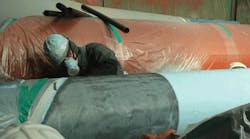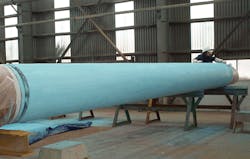The shift of oil and gas exploration, extraction and processing to offshore deep sea locations has numerous implications for those entrusted with protecting life and assets from fire. For refineries, terminals, pipelines and chemical plants onshore, there are similar concerns, because hydrocarbon fires, no matter where they occur, can reach excessively high temperatures in a matter of minutes.
Structural steel under load loses over 20 percent of its strength at 950 F (500 C), and over 50 percent of its strength by 1,100 F (600 C), depending on the width of the steel piece. A simple hydrocarbon pool fire rages at that temperature within 5 minutes; jet fires experience a rapid rise in less than 1 minute. Among the concerns with any fire event is protecting fire responders and occupants, as well as preventing the escalation of fire, blocked escape routes and outright structural collapse.
The fires most people think of are cellulosic, i.e., their fuel source is wood, carpeting or drywall and the temperature rise is more gradual. When the fuel source is hydrocarbon-based – involving gasoline, crude oil, liquid gases or solvents – certain scenarios can lead to the potential collapse of interior and exterior steel structures.
- Most common is the pool fire, resulting from the ignition of spilled cargo under normal ambient conditions. If there is a coating already protecting the steel, these fires do not erode that coating to any significant degree.
- A jet fire occurs from a leak of highly volatile liquids or gases in a high-force, pressurized situation such as a riser, pipe or vessel. These fires are very erosive of the incumbent coating.
- A cryogenic spill on liquefied natural gas (LNG) vessels and support structures could, in a matter of seconds, lead to cold-induced brittle fracture, simply from the thermal shock of going from ambient temperatures to -260 F (-162 C).
- A blast or explosion can lead to a fire if, as an example, it causes the rupture of an adjacent structure or vessel leading to the release of inventory, producing a pool fire.
The ABCs of Intumescent Coatings
To avoid catastrophic losses in a rapid-rise fire and in cryogenic spills, specifiers turn to intumescent epoxy coatings, a form of passive fire protection (PFP) that provides up to 3 hours of protection while a fire is being contained. These solvent-free (100 percent solids) coatings are applied at as much as 30 times the thickness of standard epoxy coatings and chemically react to fire by swelling to 5-10 times that original thickness. A carbon-based char forms, dramatically reducing the rate of heat transfer and extending the time for a given steel section to reach its critical failure temperature. The coating is reinforced between the first and finish coats with a fibrous mesh that supports the transition from organic epoxy resin to inorganic carbon char barrier.
A related issue concerns the normal operating temperature of the steel substrate. If it runs at ambient temperatures, protection simply can be the intumescent system alone. However, especially with processing units, if the running temperature normally is elevated, the properties of the intumescent could be activated prematurely. To avoid this, a solvent-free epoxy thermal insulating barrier coating can be specified. This barrier also allows the epoxy PFP to be used in cryogenic applications such as protection in situations where there is the possibility of release of LNG followed by a fire.
Epoxy intumescents undergo extensive independent fire testing, assessment and certification by such globally recognized organizations as Lloyd’s Register, Det Norske Veritas and ABS. In addition, because coatings must be present to work, they should provide protection against not only fire, but also corrosion under fire protection (CUF), to ensure the integrity of the structural steel’s original load-bearing capacity. To this end, it is critical to specify an intumescent coating formulated with high-quality, corrosion-resistant resins to last the design life of the asset on which it is applied, even in the harshest maritime environments, such as the North Sea. In general, these would be formulated using raw materials that don’t absorb water. Intumescent coatings also contain ammonium polyphosphate, a highly effective corrosion inhibitor.
The standards that address durability and weatherability include NORSOK M-501, revision 5, which governs surface preparation and protective coating, and UL 1709, which determines a coated steel section’s durability performance. With UL 1709, steel sections are exposed to high temperatures for 270 days, high relative humidity for 180 days, an industrial atmosphere for 30 days, salt fog for 90 days, 12 rounds of thermal cycling for 84 days and then fire tested.
Likewise with NORSOK, the testing protocols expose sections to the elements and then fire test them without a topcoat, which could mask early signs of corrosion. While damage to any fire protection system should be repaired at the earliest opportunity, an intumescent coating that passes NORSOK testing has demonstrated that mechanical damage will not lead to coating failure.
Intumescent PFP and Newbuilds
Incorporating fire protection on a project generally is actively addressed once all steel components have been designed, but due to cost, weight and safety compliance issues, consideration of it starts much earlier – in the engineering and procurement cycle – than with standard protective coatings. On a newbuild project, developing a PFP coating specification ordinarily occurs in the front end engineering and design (FEED) stage.
Each steel section has a different fire-rating requirement determined by the project’s safety assessment; the recommended coating thickness depends on that desired rating and the width of the assembly to be protected. It is advantageous to use a coating that has been engineered to perform at the lowest required film thickness. The weight impact of the PFP can be substantial, as much as 5 percent of the net platform weight. Even small weight savings can be converted to additional process equipment and living quarters.
The way this typically works is a major oil company will hire an engineering, procurement and construction (EPC) firm that establishes the specifications for the project and its component products. The EPC selects a fabricator who in turn hires the specialist PFP applicator as part of the standard procurement process. It is recommended that the fire protection be applied prior to the erection of the steel, as application at this stage greatly favors the project’s construction critical path, realized in benefits such as:
- Time savings – Smaller window for site disruption.
- Better quality – Easy access to coat the steelwork for improved quality control.
- Safety – Reduced solvent emissions and fewer trades people needed on site.
- Reduced cost – Quicker return on investment from faster construction.
The usual method of defining the limits of fire protection is through discussion and negotiation between the design team and engineers representing the asset owner, in conjunction with the insurance authorities and local and federal safety regulatory bodies.
Once the asset is protected with an intumescent epoxy, its design life should be 25-30 years. If given a choice, owners never want to shut down and bring into shore a deep-sea floating production, storage and offloading (FPSO) or floating LNG vessel for maintenance purposes.
Maintenance Applications
Asset owners always have had the option of specifying either epoxies or cementitious coatings in their maintenance programs. However, cementitious coatings are porous and can allow moisture and oxygen to reach the steel, leading to corrosion under the fire protection.
Maintenance schedules can be as frequent as every 3 to 5 years to deal with the degradation thatConcrete also gives rise to the risk of explosive spalling in the event of a fire. Spalling occurs when the moisture inside concrete turns to steam (a x1700 expansion factor), which can cause it to break into pieces at high velocity if it is not porous enough or the temperature rise is too rapid. The safety hazard this presents is obvious, and the remedy for it is often triple the original cost of the fireproofing.
Hydrocarbon fires present risk managers with a special set of protection issues compared to those where the fuel source is wood or building materials. Hydrocarbon fires behave very differently, use different fire protection products and involve different approvals than cellulosic fires. Fortunately, coating technologies are available to address not only a hydrocarbon fire event itself, but also to provide the necessary corrosion resistance that ensures the coating will be there when and if it’s needed for the design life of the asset.
Roger Williams is the global market director, Fire Protection, for the Sherwin-Williams Co. He has been involved with fire protection for more than 25 years, beginning with an ownership interest in a fireproofing application company for 16 years. He previously worked in sales, marketing and operations for a leading protective coatings company specializing in fire protection. He is based in the U.K. and joined Sherwin-Williams in 2011.

